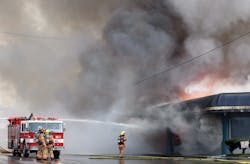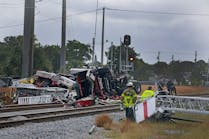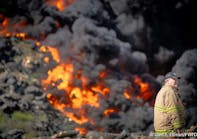On The Job Oregon: Two-Alarm Fire Destroys Roseburg Furniture Store
ROSEBURG FIRE DEPARTMENT
Chief: Mike Lane
Personnel: 42 career firefighters
Stations: 3
Apparatus: 3 pumpers, 1 aerials, 2 brush engines, 2 hazmat vehicles, 1 rehab vehicle, 2 reserve engines, 1 reserve truck
Population: 21,290
Area: 11 square miles
2013 Fire Calls: 132
2013 EMS Calls: 3,358
On Sunday, March 16, 2014, a two-alarm fire destroyed a 70-year-old furniture business in downtown Roseburg, OR. Because the first-in engine company was directed to a probable rescue, crews were hampered trying to get water to the fire scene quickly. The store contained a huge fire load of furniture, which caused a flashover within 40 minutes of arrival. Also, limited access to the building made firefighting operations difficult.
The two-story building featured a reinforced concrete exterior and a heavy-timber interior. It was built in 1952 and had a flat roof with a single-ply rubber membrane roof. The first floor contained 7,220 square feet and the second floor contained 14,658 square feet of usable space. There were no fire detection or protection systems in the building.
First alarm dispatched
The Roseburg Fire Department was dispatched to a reported fire at Kuebler’s Furniture Store at 1100 N.E. Stephens St. at 5:13 P.M. Responding on the first alarm were Engines 1332 and 1333, both 1,500-gpm pumpers, and Ladder 1351, a 100-foot aerial platform with a 1,500-gpm pump, with nine firefighters under the command of Battalion Chief Dan McLain. Douglas County Fire District Number 2 responded with an advanced life support (ALS) ambulance.
Engine 1333 was first to arrive on scene at 5:16 P.M. Firefighters found a large volume of turbulent, black smoke coming from the Bravo side of the building around the loading dock door frame. All of the building’s doors were found to be closed and locked, as the business had closed for the day at 5 P.M. The fire appeared to be located near the loading dock on the Bravo side.
A Roseburg police officer advised Engine 1333 that an employee normally stays late on the weekends. He also noted it was not uncommon for her to be inside after 5 P.M. The first-in company officer, Lieutenant Scott Radmer, believed there was a probable rescue situation and notified McLain that he was going to be in rescue mode. This engine was positioned near the loading dock doors and hooked onto a hydrant less than 100 feet away with a five-inch supply line. This hydrant was on a six-inch feed from a 12 inch water main.
The crew pulled a 200-foot 2½-inch attack line and used a rescue saw to access a metal-clad man door on the Bravo side to enter the building briefly to check for a victim. Radmer realized that the fire conditions inside would not sustain life and backed his crew out.
Ladder 1351 hooked onto a hydrant approximately 200 feet north of the building with a 200-foo, five inch supply line and was positioned on the Delta side. This hydrant was on a six-inch feed from a 12-inch water main. Engine 1332 was staged and its crew was assigned to assist other crews. Lieutenant FIRST NAME? Kormendi was assigned as scene safety officer.
Second-alarm units called
McLain requested a general alarm for off-duty personnel at 5:18 P.M. Thirteen additional personnel responded to the scene with Rehabilitation Rig 1391; Reserve Ladder Truck 1353, a 75-foot aerial ladder with a 1,500-gpm pump; and Engines 1331 and 1341, both 1,500-gpm pumpers. Rehabilitation Rig 1391 was positioned near the command post on Chestnut Street near the Bravo/Charlie corner of the building and Ladder 1553 and Engine 1341 were staged.
Engine 1331laid a 200-foot, five-inch supply line from a hydrant 200 feet south of the building and was positioned on the Alpha side. This hydrant was on a six-inch feed from a 12-inch water main. Engine 1331 placed its deck gun into operation along with a 200-foot 2½-inch attack line and two 200-foot 1¾-inch attack lines. The air rig from Douglas County Fire District Number 2 responded for mutual aid late into the fire to refill self-contained breathing apparatus (SCBA) bottles.
McLain assumed command and operations were initiated at the Alpha (front of store) and Charlie divisions. After the door was forced on the Bravo side and crews did an initial search, rescue operations were moved to the Charlie-side man door due to this being the least burned portion of the structure. McLain thought the seat of the fire could be accessed through the Charlie side and crews made an interior attempt to locate the fire from the rear of the structure.
Entry was made with one team of two with a backup team of two remaining at the door, both using 200-foot 1¾-inch attack lines from Truck 1351. A 200-foot 1¾-inch attack line was placed into operation as a backup line from Truck 1351. Interior crews notified command roughly 30 minutes from time of arrival on scene that interior conditions were deteriorating. Command ordered all crews out of the interior and went to defensive operations. Personal Accountability Reports (PARs) were requested from all units and were received.
Defensive operations
At that time, crews had lines going into multiple areas of the building. On the Alpha side a master stream was flowing 1,000 gpm from Engine 1331 along with one 2½-inch line and two 1 ¾-inch lines. The Bravo side had a deck gun, a portable monitor and a 2½-inch line in operation from Engine 1333 and Truck 1351 was set up on the Delta side operating two aerial master streams flowing 2,000 gpm. An air rig from Douglas County Fire District Number 2 responded for mutual aid late into the fire to refill SCBA bottles.
McLain declared the fire under control at 10 P.M. One engine and one ladder remained on scene until 9 A.M., Monday, March 17 to control hot spots and to secure the scene until it was turned over to arson investigators.
Conclusion
Four engines, one aerial, four deck guns, one portable monitor and numerous 1¾-inch and 2½-inch handlines were used by 22 firefighters to control the fire. Three hydrants on the municipal water system supplied approximately one million gallons of water used to extinguish the fire. One firefighter suffered a minor leg injury when the legs of a master stream device failed. The firefighter was transported to Mercy Medical Center for treatment.
Investigators from the Roseburg Fire Department, Roseburg Police Department, Oregon State Fire Marshal, Oregon State Police and insurance companies conducted an origin-and-cause investigation. The investigation is ongoing at this time. Damage was estimated at $1.425 million.
LESSONS LEARNED
PROBLEMS
• The first-in engine company was directed to a probable rescue. The initial rescue attempt upon arrival hampered crews getting water to the fire scene quickly.
• There was a huge fire load of furniture in the structure, which caused a flashover and fire vented through the roof within 40 minutes of arriving on scene.
• Limited building access made firefighting operations difficult.
SUCCESSES
• Crews were able to establish water supplies quickly due to the hydrant layout of the city.
• Good communications and accountability on the fireground with crews using good PARS and keeping safety at the forefront on their minds.
• Arriving off-duty companies knew their assignments and the mission at hand and implemented it.
• In terms of apparatus, water supply and personnel the fire department was very prepared for this fire. Once there was an all-clear of the structure, due to the heavy fire loading and BTUs, the fire had already advanced into the roof space and vented. At that time, crews were evacuated and they went into defensive operations.
The Roseburg Fire Department spends countless hours each year training for structure fires. That training has focused on fireground operations and task-oriented jobs such as pulling lines, ventilation and truck operations. The department is developing a chief and company officer training program that will give personnel more tactics and advanced fire behavior training as it pertains to larger commercial structures.
• Citywide Incident Command System (ICS) training worked.
• Police arrived at the command post and remained there to provide increased communications, ensuring safety throughout the incident.
—Jay K. Bradish
Jay K. Bradish
JAY K. BRADISH/IFPA, is the news editor editor of Firehouse® magazine and a former captain in the Bradford Township, PA, Fire Department. He has been a volunteer firefighter and fire photographer for more than 25 years.






